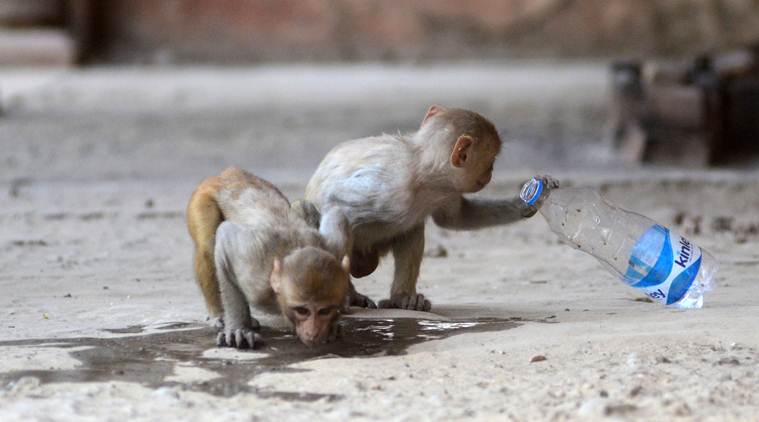 The Punjab and Haryana Civil Secretariat, which houses the offices of chief ministers of both states, the cabinet ministers and the offices of top bureaucrats, has been taken over by monkeys. (Picture for representation)
The Punjab and Haryana Civil Secretariat, which houses the offices of chief ministers of both states, the cabinet ministers and the offices of top bureaucrats, has been taken over by monkeys. (Picture for representation)
A CENTRAL Industrial Security Force (CISF) jawan guarding a post on Punjab side of the Civil Secretariat is all alert to foil any intrusion but is wary of the group of monkeys which move with impunity. A sweeper inside the building on Haryana side is cleaning the floor and at the same time shooing away the monkeys that have made their way from the balcony.
The Punjab and Haryana Civil Secretariat, which houses the offices of chief ministers of both states, the cabinet ministers and the offices of top bureaucrats, has literally been taken over by monkeys.
Officials at the Chandigarh forest and wildlife department say no count is available of monkeys around the secretariat and in Chandigarh. The authorities concerned of the two states have been trying everything they can to address the monkey menace in the secretariat.
Among the ideas being mooted is the use of slingshots to scare away monkeys. The CISF which guards the secretariat is not keen to go for it as an official says that if a shot from slingshot goes wrong, it may hit an individual.
An official of the Punjab’s general administration department claims that in a recent meeting, the CISF said they were using “desi slingshots” made of fallen tree branches. “We had offered that we can provide them professional slingshots,” said the official.
A CISF functionary said that the slingshot was a “jugaad” (a stop-gap arrangement) being used by the CISF personnel to “protect themselves”.
“It is not CISF’s duty to shoo away the monkeys. Our duty is to stop any intrusion or any terrorist attack. How can we stop or shoo away monkeys? We were asked to use slingshots. But what if the shot hits people? The best solution is monkey catchers. The government should engage monkey catchers,” said the functionary.
In fact, the officials at the secretariat have been availing of the services of individuals who are “expert in mimicking the voice of langurs” to shoo away the monkeys. Monkeys as a matter of fact fear langurs. But the officials feel “experts” come for a limited time and when they go back, the monkeys make a comeback.
Late last year, the Punjab government’s general administration department wrote to the Chandigarh Chief Conservator of Forests & Wildlife Warden seeking to station at least two experts called “wildlife rescue staff” from 8:30 am to 5:30 pm in and around the Punjab and Haryana Civil Secretariat so that employees and visitors may feel secure from monkeys. The Chandigarh forests and wildlife department has outsourced a team of about a dozen experts who specialise in monkey catching and rescuing other wildlife, including deer. The team members also include men who are expert snake catchers.
Chandigarh Deputy Conservator of Forests and Wildlife Dr Abdul Qayyum said it was impossible to station two of the rescue team members for such long hours at the secretariat. “We have a team of about a dozen and we have 40 locations in the city to cover. Once a complaint is made, the team members reach the spot within 30 minutes. It is practically not possible to station two team members at one place,” said Dr Qayyum, adding that the department was taking novel initiatives like developing fruit-bearing patches in the sanctuaries so that the monkeys remain there.
Dr Qayyum said the people were also to be blamed for monkey menace as they throw left-out food, which invites the monkeys. “We have also written to Chandigarh Municipal Corporation to manage such garbage in an effective way,” he said.
However, the members of the rescue teams say that they are ready to work full-time at secretariat if suitably paid. “If they want to retain us, they will have to pay. They have deployed hundreds of personnel for security. Why cannot they hire two experts to shoo away monkeys?” said Gaffar, the contractor of the wildlife rescue team. “They can pay as per the DC rate. It works out to be around Rs 15,000 per month per person.”
“We come from madaari (a clan of street performer which is known to tame monkeys for the street shows) families,” Gaffar said. “As per new regulations, after catching the monkey, you have to release it in a sanctuary as soon as possible. You cannot keep the animal in a cage or enclosure for long.”
A senior CISF official said the best way is to avoid any eye contact. “The other day, one monkey caught hold of my jacket from behind. I did not turn and kept moving. The monkey went away,” he said.